Archaeology in the City of London: an end and a beginning 1972-6
Gustav Milne
PART ONE- A CASTLE AND A CRISIS
Although the Museum of London closed in December 2022, its remarkable archaeological legacy remains.
But the genesis of the Museum’s pioneering Department of Urban Archaeology (DUA) began fifty years ago in Easter 1972 with the Guildhall Museum, long before MoL had even opened. Faced with a looming deadline, an army of volunteers were recording the remains of a medieval castle, threatened by redevelopments for a new road. 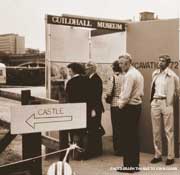 That was how archaeology was conducted in the City of London in those days: enthusiastic amateurs working against the clock with minimal professional help or state support. But then things changed dramatically: by the end of 1973, a new professional unit, the Department of Urban Archaeology (DUA) had been established, and the most productive era of archaeological excavation and research in the City began. How was such a radical transformation possible in such a short period? It was as unforeseen as it was unimagined over that Bank Holiday weekend. But the answer actually lies in those rushed investigations of Baynard’s Castle, and the seismic impact they had.
That was how archaeology was conducted in the City of London in those days: enthusiastic amateurs working against the clock with minimal professional help or state support. But then things changed dramatically: by the end of 1973, a new professional unit, the Department of Urban Archaeology (DUA) had been established, and the most productive era of archaeological excavation and research in the City began. How was such a radical transformation possible in such a short period? It was as unforeseen as it was unimagined over that Bank Holiday weekend. But the answer actually lies in those rushed investigations of Baynard’s Castle, and the seismic impact they had.
BAYNARD’S CASTLE 1972: A Crisis Unfolds
The first systematic excavations on the City waterfront in London took place in 1972 at Baynard’s Castle, near Blackfriars Bridge. Many of the waterfront warehouses here from Puddle Dock to St Paul’s Stairs had been burnt out in the Blitz, a distance of nearly a quarter of a mile.  Most of the remains had been cleared away prior to redevelopment, and so the proposed archaeological investigation was an example of “Rescue Archaeology”. This term then applied to excavations that took place just before rebuilding began. London was already in the throes of a major reconstruction, with 19th-century offices and warehouses being torn down and replaced by high-rise buildings with deep basements.
Most of the remains had been cleared away prior to redevelopment, and so the proposed archaeological investigation was an example of “Rescue Archaeology”. This term then applied to excavations that took place just before rebuilding began. London was already in the throes of a major reconstruction, with 19th-century offices and warehouses being torn down and replaced by high-rise buildings with deep basements.
In this era, there was no developer-funding and only modest state support for such work. There were many willing voluntary helpers, but few experienced professional archaeologists. The programme of post-Blitz excavations conducted by Professor Grimes with the Roman & Medieval Excavation Council had stopped by 1968. The Guildhall Museum employed just one archaeologist in 1972, Peter Marsden, responsible for the whole City. By contrast, the impoverished London Borough of Southwark, on the opposite bank of the river, had established the first professional unit in London in that year, employing a fulltime Field Officer supported by a team of site assistants.
The Guildhall Museum’s access to the large Baynard’s Castle site was initially scheduled to last for five months over the spring and summer of 1972. As work progressed, the remarkable archaeological potential of London’s waterfront was unequivocally revealed here: deep relatively undisturbed stratigraphy, with organics such timber, textiles and leather as well as metalwork all excellently preserved. But then the developer of the projected road scheme suddenly truncated this period to just one month, a terrible blow to the team on site.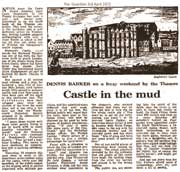 This was, however, an ideal cause celebre for Rescue, the Trust for British Archaeology, a vocal pressure group founded in the previous year. It was highlighting the shameful national provisions currently enjoyed by archaeology, in a country where sites were wantonly destroyed without record by urban redevelopment, motorway construction, quarrying and deep ploughing.
This was, however, an ideal cause celebre for Rescue, the Trust for British Archaeology, a vocal pressure group founded in the previous year. It was highlighting the shameful national provisions currently enjoyed by archaeology, in a country where sites were wantonly destroyed without record by urban redevelopment, motorway construction, quarrying and deep ploughing.
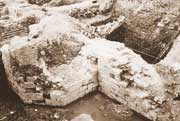 And here was a prime example, sitting in the very heart of the capital city. Rescue’s robust chairman, Martin Biddle, visited the Baynard’s Castle site on 21st of March, and helped orchestrate a vigorous press campaign, with a primary focus on the desperate recording over the Easter week from 30th March to 3rd April.
And here was a prime example, sitting in the very heart of the capital city. Rescue’s robust chairman, Martin Biddle, visited the Baynard’s Castle site on 21st of March, and helped orchestrate a vigorous press campaign, with a primary focus on the desperate recording over the Easter week from 30th March to 3rd April.
 What could have been a modest but interesting diversion concerning City history now became front page news: the national press, with their headquarters conveniently just a few hundred yards away in Fleet Street, converged on the photogenic site. They ran stories about developers destroying our heritage before it had been adequately recorded, and levelled sharp criticism at the Corporation of London. This even led to questions raised in Parliament on the 12th, 19th and 26th of April. Nevertheless, few would have predicted that this storm in a tea cup would serve as the catalyst for a fifty-year programme of research and excavation, including one of the largest such medieval waterfront projects in Europe. But so it proved.
What could have been a modest but interesting diversion concerning City history now became front page news: the national press, with their headquarters conveniently just a few hundred yards away in Fleet Street, converged on the photogenic site. They ran stories about developers destroying our heritage before it had been adequately recorded, and levelled sharp criticism at the Corporation of London. This even led to questions raised in Parliament on the 12th, 19th and 26th of April. Nevertheless, few would have predicted that this storm in a tea cup would serve as the catalyst for a fifty-year programme of research and excavation, including one of the largest such medieval waterfront projects in Europe. But so it proved.
PART TWO: SEEKING SOLUTIONS
An Opportunity
The deep underlying uncertainties of this period were highlighted by two assessment reports on how the future of the City’s threatened archaeological sites should and could be addressed. Two rather different approaches were presented. The first, Archaeology in the City of London: an Opportunity was produced by Max Hebditch, the new Director of the Guildhall Museum, in 1972. It was addressed squarely at the hearts and minds of Corporation of London, in an attempt to facilitate a rather more responsible structure and proactive attitude to the City’s archaeological heritage. Although brief, it nevertheless represented a genuinely progressive initiative, given the broadly unsympathetic view of archaeological matters that the Corporation of London seemed to hold. Certainly the pace of City development was increasing: there were 16 major planning consents granted in 1970, 29 in 1971 and 34 in just the first half of 1972. In the new summary report, these potential redevelopments were then to be assessed at the planning stage, based on their assumed historic value. They were then mapped out and prioritised, with priority Category One sites flagged up for detailed scientific investigation in advance of redevelopment (ie not just watching briefs during a contractor’s groundworks programme). These included the rich waterfront deposits “archaeologically among the most rewarding in Northern Europe”, as demonstrated at Baynard’s Castle.
The Future of London’s Past
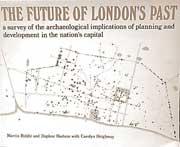 The second report, The Future of London’s Past, presented an even more ambitious solution for the City, researched, evaluated, mapped and costed in 83 detailed pages. Again, a new urban unit was proposed, but this larger team would cost some £109,273 per annum, based initially on the models provided by the recent work in, eg York and Winchester. The report published in the summer of 1973 enjoyed further press coverage, including a leader in the Times. Although the named authors were Martin Biddle, Daphne Hudson and Carolyn Heighway, full acknowledgment is made of the assistance provided by Max Hebditch and his Guildhall Museum team, and even to the chief officers and various departments of the Corporation of London itself. It can therefore be regarded not as a rival approach to An Opportunity but as a carefully researched fusion and expansion of the Guildhall scheme.
The second report, The Future of London’s Past, presented an even more ambitious solution for the City, researched, evaluated, mapped and costed in 83 detailed pages. Again, a new urban unit was proposed, but this larger team would cost some £109,273 per annum, based initially on the models provided by the recent work in, eg York and Winchester. The report published in the summer of 1973 enjoyed further press coverage, including a leader in the Times. Although the named authors were Martin Biddle, Daphne Hudson and Carolyn Heighway, full acknowledgment is made of the assistance provided by Max Hebditch and his Guildhall Museum team, and even to the chief officers and various departments of the Corporation of London itself. It can therefore be regarded not as a rival approach to An Opportunity but as a carefully researched fusion and expansion of the Guildhall scheme.
In addition to the excellent research the Future of London’s Past incorporated, there were two essential new elements that ultimately predicated success. The first was the fortuitous arrival in the Department of Environment of a new Chief Inspector of Ancient Monuments. Andrew Saunders was eager to formulate and deliver a new supportive, proactive national policy for Rescue Archaeology, which he tabled in February 1973.
 The second element was the tie-in with the proposed new Museum of London (an amalgamation of the former London Museum in Kensington and the Guildhall Museum in the City): such a bold new organisation could more readily absorb new responsibilities.
The second element was the tie-in with the proposed new Museum of London (an amalgamation of the former London Museum in Kensington and the Guildhall Museum in the City): such a bold new organisation could more readily absorb new responsibilities.
Meanwhile, Max Hebditch presented his Guildhall Museum report to the Court of Common Council of the Corporation of London: duly chastened by the Baynard’s Castle affair, this was accepted by them on 28th June 1973. By July, it was agreed that a core team comprising a Chief Urban Archaeologist (CUA) and four assistants would be appointed, while the necessary excavators would be employed site by site, on a fees-&- subsistence basis paid by the Department of Environment (diggers didn’t deserve salaries then).
The Department of Urban Archaeology for the City of London was to be established initially as part of the Corporation’s Guildhall Museum. Adverts were subsequently posted on the 10th August: they would initially be employed by the Guildhall, since the constitution of the Museum of London was still being formulated. Indeed, construction on its new Barbican building had only just begun, with its foundation stone laid by Queen Elizabeth the Queen Mother in March 1973. Nevertheless, with surprising speed, the Guildhall Museum inaugurated the DUA in December 1973: a series of waterfront sites were already under excavation in or by 1974 at eg New Fresh Wharf, Swan Lane and Trig Lane, a full two years before the real Museum of London actually opened in December 1976.
PLANS OF ACTION
The Future of London’s Past was clearly Influenced by the infamous Baynard’s Castle affair. It unequivocally declared that “the history of the  waterfront is critical for all periods of London archaeology…the potential and requirements of the archaeology of the (medieval) waterfront present remarkable opportunities as well as the requisite of large scale excavation, and its associated research and publication” (Biddle et al 1973, 4.14; 4.53). This influential publication proved prophetic with regard to the singular value of these rich sites. But it also stressed that the pace of redevelopment in the City was such that archaeologists had no time to waste. “Within about ten years (ie by 1983) the archaeological deposits along the waterfront will have been destroyed. Within fifteen years or twenty at most (ie by 1988-1993) the other areas of the City still undeveloped since 1945 will have been renewed” (Biddle et al 1973, 8.3). This was a powerful wake-up call. Although with hindsight, the report’s predicted timeline proved less than accurate, in 1973 the message underpinning the urgency for immediate action struck home.
waterfront is critical for all periods of London archaeology…the potential and requirements of the archaeology of the (medieval) waterfront present remarkable opportunities as well as the requisite of large scale excavation, and its associated research and publication” (Biddle et al 1973, 4.14; 4.53). This influential publication proved prophetic with regard to the singular value of these rich sites. But it also stressed that the pace of redevelopment in the City was such that archaeologists had no time to waste. “Within about ten years (ie by 1983) the archaeological deposits along the waterfront will have been destroyed. Within fifteen years or twenty at most (ie by 1988-1993) the other areas of the City still undeveloped since 1945 will have been renewed” (Biddle et al 1973, 8.3). This was a powerful wake-up call. Although with hindsight, the report’s predicted timeline proved less than accurate, in 1973 the message underpinning the urgency for immediate action struck home.
Way back in 1954, the publicity engendered by the infamous Temple of Mithras affair proved decidedly counterproductive for the City’s archaeology in the longer term, driving a sharp wedge between developers and archaeologists. Twenty years later, the Baynard’s Castle incident could likewise have sent provision for archaeology spinning backwards (Hebditch 1978, 30). Instead it proved to be a dramatic catalyst not just for the inauguration of the City’s waterfront project but for a comprehensive restructuring of London’s archaeological provision. Without it, it would have taken rather longer to make the progress the DUA subsequently achieved, and several sites would have been lost. In 1971, before Baynard’s, the 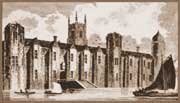 Guildhall Museum’s archaeological budget was £8,140. After the publicity generated by Baynard’s it rose to £17,695 in 1972 and led directly to the establishment of the DUA the following year. Just three years later in 1975 when the Museum of London finally came into being, the DUA already had an annual budget of an eye-watering £250,000 (Hebditch 1978, 31).
Guildhall Museum’s archaeological budget was £8,140. After the publicity generated by Baynard’s it rose to £17,695 in 1972 and led directly to the establishment of the DUA the following year. Just three years later in 1975 when the Museum of London finally came into being, the DUA already had an annual budget of an eye-watering £250,000 (Hebditch 1978, 31).
The expertise enjoyed by the Department of Urban Archaeology was solidly based on the Guildhall Museum’s excavations from 1972-3 onward. That Museum’s increasingly pro-active approach to rescue archaeology saw professional teams operating on a range of sites across the City, always welcoming volunteer support. Initially, these included excavations supervised by Tony Johnson at Christchurch Grey Friars, Hugh Chapman at Aldgate and Tim Tatton-Brown at Custom House. It was on such sites as these that a core of archaeologists (paid or unpaid) who went on to work on later DUA sites were trained. The Guildhall Museum team (curators, archaeologists and all) and the London Museum team were finally formally brought together within the new Museum of London in June 1975, even though the London Wall site was not officially opened until December 1976, by Queen Elizabeth II.
Although the highly successful Department of Urban Archaeology and its sister unit the Department of Greater London Archaeology were closed down in 1991, the fields records and much of the expertise and legacy were incorporated into the Museum of London Archaeological Service (now MOLA).
It seems a shame that the proposed new museum, to open in 2026-ish, should be called The London Museum, effectively airbrushing out the Museum of London’s hard won contributions to our capital’s deep history. Fifty years on, London archaeologists also need to remember the debts to Max Hebditch and his Guildhall Museum team (perhaps the well-known website should be renamed the Hebditch Heroes?), as well as the debts to Rescue, to Fleet Street and, most of all, to the remains of a photogenic but now forgotten castle.




Comments powered by CComment